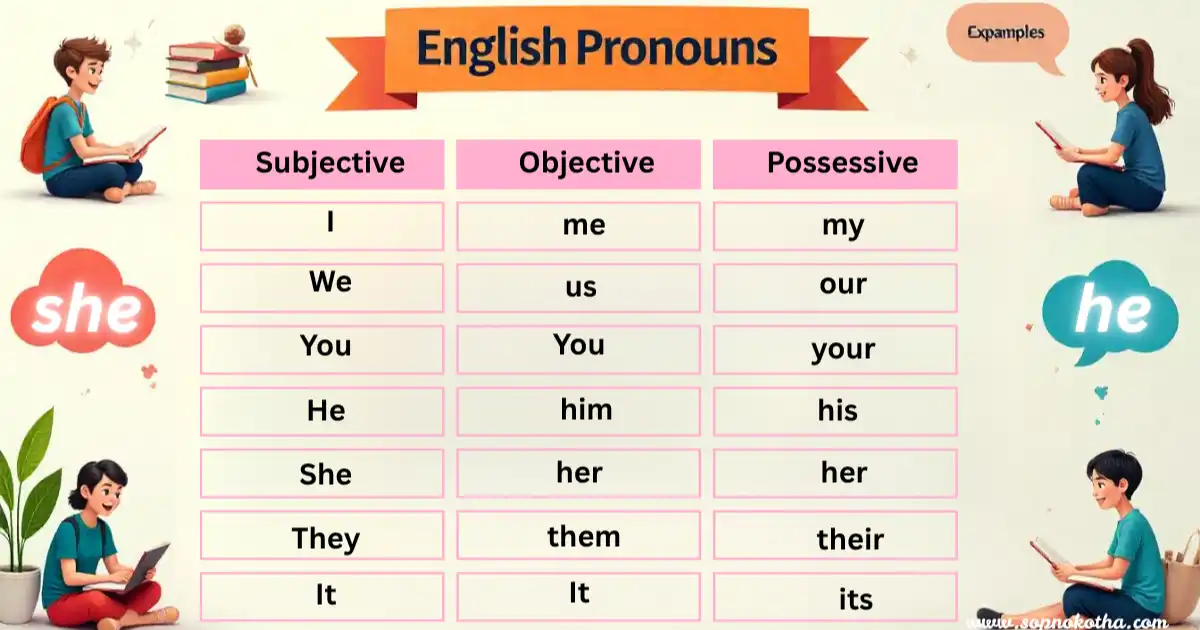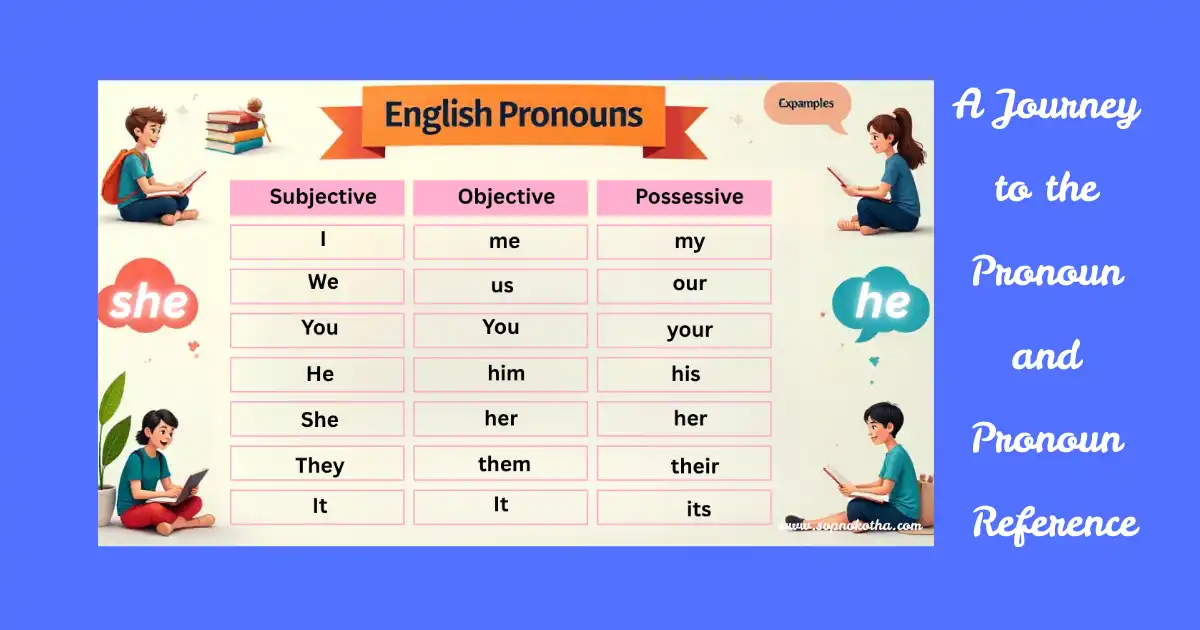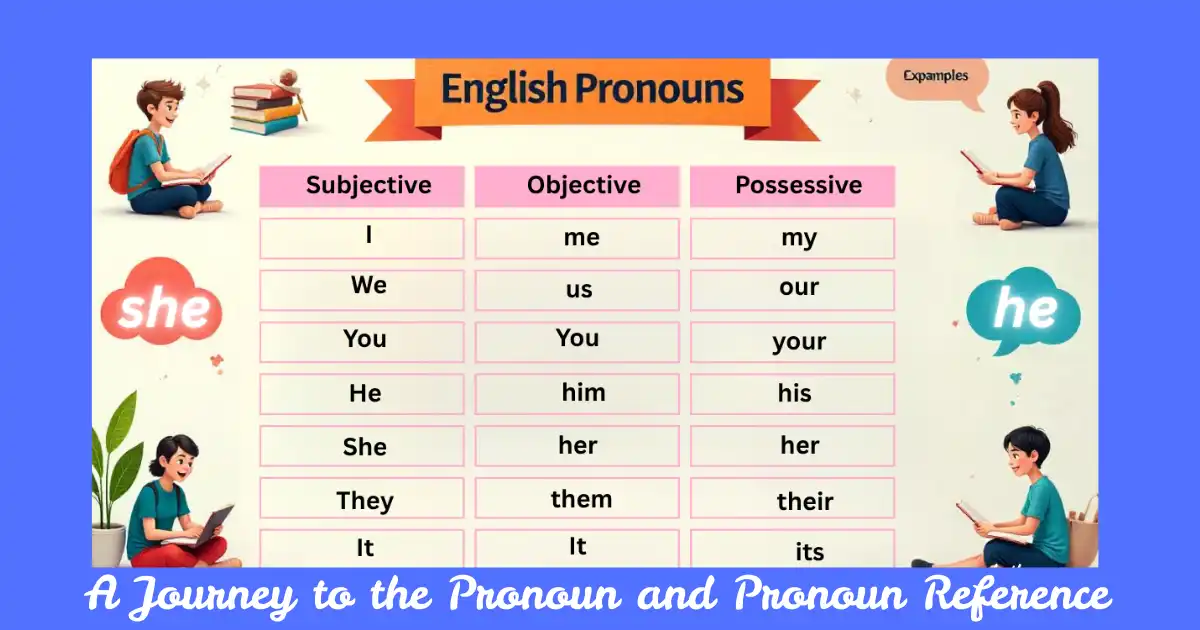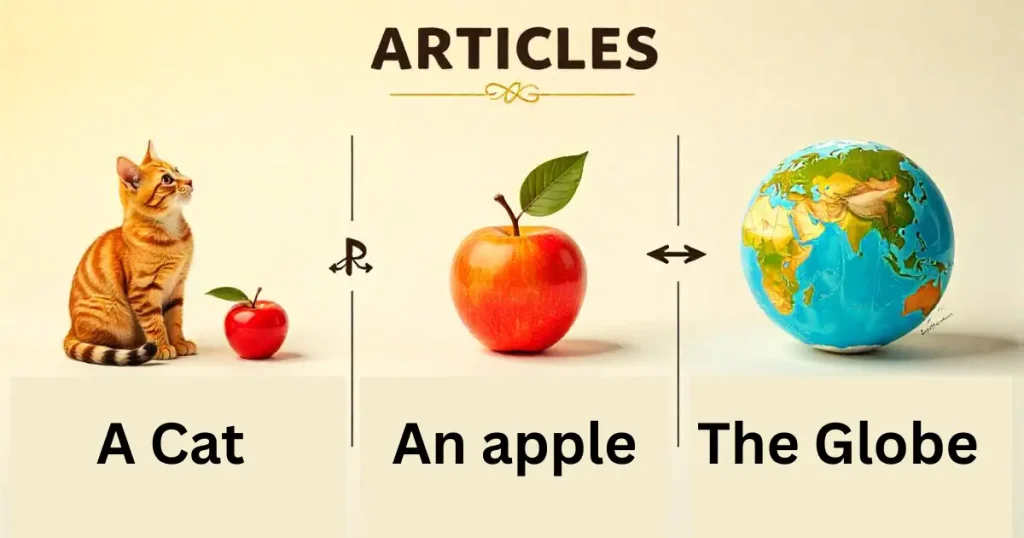Pronoun and Pronoun Reference
Pronoun হল এমন একটি গুরুত্বপূর্ণ ব্যাকরণগত উপাদান যা Noun-এর পরিবর্তে ব্যবহৃত হয়ে বাক্যকে সংক্ষিপ্ত ও প্রাঞ্জল করে তোলে এবং ভাষার সৌন্দর্য বৃদ্ধি করে। Pronoun, Noun এর পুনরাবৃত্তি কমিয়ে বাক্যকে সহজবোধ্য করে তোলে। সঠিকভাবে Pronoun ব্যবহার করলে বাক্য হবে স্পষ্ট, কার্যকর ও আকর্ষণীয়।

এই প্রবন্ধটি শিক্ষার্থীদের জন্য উপকারী হওয়ার পাশাপাশি ২০টি অবজেক্টিভ প্রশ্ন এবং ১০টি প্র্যাকটিস বাক্যসহ সাজানো হয়েছে। এছাড়াও প্রবন্ধে Pronoun বাক্যের কোথায় এবং কীভাবে ব্যবহৃত হয় সে সম্পর্কেও বিস্তারিত নির্দেশনা প্রদান করা হয়েছে। পরিশেষে Pronoun Reference নিয়েও রয়েছে বিস্তারিত আলোচনা।
Read more – Nouns – 3 Easy Ways to Identify in Sentences
Pronoun এর Singular ও Plural Form
Pronoun (সর্বনাম) হল এমন একটি শব্দ যা Noun-এর পরিবর্তে ব্যবহৃত হয়। Pronoun-এর Singular (একবচন) ও Plural (বহুবচন) রূপ থাকে, যা Number ও Person অনুযায়ী পরিবর্তিত হয়।
Singular ও Plural Pronoun এর তালিকা
| Pronoun Type | Singular (একবচন) | Plural (বহুবচন) |
| Subject Pronoun | I, You, He, She, It | We, You, They |
| Object Pronoun | Me, You, Him, Her, It | Us, You, Them |
| Possessive Pronoun | Mine, Yours, His, Hers, Its | Ours, Yours, Theirs |
| Possessive Adjective | My, Your, His, Her, Its | Our, Your, Their |
| Reflexive Pronoun | Myself, Yourself, Himself, Herself, Itself | Ourselves, Yourselves, Themselves |
| Indefinite Pronoun | Someone, Anyone, Everyone, No one | Some, Any, All, Few, Many |
Pronoun এর Singular ও Plural রূপের ব্যাখ্যা
- Subject Pronoun:
- Singular: He is a teacher.
- Plural: They are teachers.
- Object Pronoun:
- Singular: She gave me a book.
- Plural: She gave us books.
- Possessive Pronoun:
- Singular: This pen is mine.
- Plural: These pens are ours.
- Possessive Adjective:
- Singular: This is my car.
- Plural: This is our car.
- Reflexive Pronoun:
- Singular: I did it myself.
- Plural: We did it ourselves.
- Indefinite Pronoun:
- Singular: Someone is knocking at the door.
- Plural: Some are waiting outside.
Table of Subjective, Objective, and Possessive Pronouns
| Type | Singular Pronouns | Plural Pronouns |
| Subjective Pronoun (Used as the subject of a sentence) | I, You, He, She, It | We, You, They |
| Objective Pronoun (Used as the object of a verb or preposition) | Me, You, Him, Her, It | Us, You, Them |
| Possessive Pronoun (Shows ownership, replaces a noun) | Mine, Yours, His, Hers, Its | Ours, Yours, Theirs |
| Possessive Adjective (Shows ownership, modifies a noun) | My, Your, His, Her, Its | Our, Your, Their |
🔹 Example Sentences:
Subjective: He is my friend. (He is the subject.)
Objective: She gave me a book. (Me is the object.)
Possessive Pronoun: This book is mine. (Mine replaces “my book.”)
Possessive Adjective: This is my book. (My modifies “book.”)
Pronoun এর শ্রেণীবিভাগ
Pronoun সাধারণত আটটি প্রধান শ্রেণীতে বিভক্ত:
- Personal Pronoun
- Possessive Pronoun
- Reflexive Pronoun
- Demonstrative Pronoun
- Interrogative Pronoun
- Relative Pronoun
- Indefinite Pronoun
- Reciprocal Pronoun

Read more – Craft: Powerful Insights into the Timeless Beauty U2L4
Pronoun এর শ্রেণীবিভাগের বিস্তারিত আলোচনাঃ
1. Personal Pronoun
ব্যক্তি বা বস্তুর স্থান পরিবর্তনে ব্যবহৃত হয়।
- উদাহরণ: I, we, you, he, she, it, they.
- I am going to the market.
- They are watching a movie.
2. Possessive Pronoun
কোনো কিছুর মালিকানা নির্দেশ করে।
- উদাহরণ: Mine, yours, his, hers, ours, theirs.
- This book is mine.
- The house is theirs.
3. Reflexive Pronoun
Subject এবং Object একই ব্যক্তি হলে ব্যবহৃত হয়।
- উদাহরণ: Myself, yourself, himself, herself, itself, ourselves, yourselves, themselves.
- She made it herself.
- We enjoyed ourselves.
4. Demonstrative Pronoun
কোনো নির্দিষ্ট বস্তু বা ব্যক্তি নির্দেশ করতে ব্যবহৃত হয়।
- উদাহরণ: This, that, these, those.
- This is my pen.
- Those are beautiful flowers.
5. Interrogative Pronoun
প্রশ্ন করার জন্য ব্যবহৃত হয়।
- উদাহরণ: Who, whom, whose, what, which.
- Who is calling you?
- What is your name?
6. Relative Pronoun
দুটি বাক্য বা Clause কে যুক্ত করে।
- উদাহরণ: Who, whom, whose, which, that.
- The boy who won the prize is my brother.
- This is the book that I was reading.
7. Indefinite Pronoun
নির্দিষ্ট ব্যক্তি বা বস্তু ছাড়া ব্যবহৃত হয়।
- উদাহরণ: Someone, anyone, everyone, no one, nothing, anything.
- Someone is knocking at the door.
- Nobody knows the truth.
8. Reciprocal Pronoun
দুটি বা তার বেশি ব্যক্তির পারস্পরিক ক্রিয়ার ক্ষেত্রে ব্যবহৃত হয়।
- উদাহরণ: Each other, one another.
- The friends help each other.
- They respect one another.
বাক্যে Pronoun এর অবস্থান
Pronoun সাধারণত বাক্যে Subject, Object, বা Possessive রূপে ব্যবহৃত হয়।
- Subject: Pronoun বাক্যের শুরুতে ব্যবহার হয়, যখন এটি কাজটি করে।
- উদাহরণ: He is reading a book.
- Object: Pronoun Verb বা Preposition-এর পরে বসে।
- উদাহরণ: The teacher called him.
- Possessive: Pronoun মালিকানা বোঝাতে Noun-এর আগে বা পরে ব্যবহৃত হয়।
উদাহরণ: This is her book.
Pronoun Reference কী?
Pronoun Reference হল এমন একটি ব্যাকরণগত নিয়ম যেখানে Pronoun-এর মাধ্যমে পূর্বে উল্লেখিত Noun বা Phrase-এর প্রতি ইঙ্গিত করা হয়। এটি ভাষার স্পষ্টতা এবং সাবলীলতা বজায় রাখতে সাহায্য করে।
উদাহরণ:
- Rahim is a good student. He always completes his homework on time.
এখানে He এবং his শব্দ দুটি Rahim কে নির্দেশ করছে, যা Pronoun Reference-এর একটি উদাহরণ।
Pronoun Reference-এর ধরন
Pronoun Reference সাধারণত তিন ধরনের হতে পারে:
- Clear Reference (সুস্পষ্ট নির্দেশনা)
- Pronoun-টি যে Noun-এর পরিবর্তে ব্যবহৃত হয়েছে, তা স্পষ্টভাবে বোঝা যায়।
- উদাহরণ:
- Sarah said that she would come tomorrow.
- এখানে she স্পষ্টভাবে Sarah কে নির্দেশ করছে।
- Ambiguous Reference (অস্পষ্ট নির্দেশনা)
- যদি একাধিক Noun থেকে বোঝা না যায় যে Pronoun কোনটির পরিবর্তে ব্যবহার হয়েছে, তবে এটি Ambiguous Reference হয়।
- ভুল উদাহরণ:
- When Ali met Karim, he was very happy.
- এখানে he বলতে Ali নাকি Karim বোঝানো হয়েছে, তা স্পষ্ট নয়।
- সঠিক বাক্য:
- When Ali met Karim, Ali was very happy. (এখানে Pronoun বাদ দিয়ে নাম ব্যবহার করা হয়েছে)
- Vague Reference (অনির্দিষ্ট নির্দেশনা)
- যখন Pronoun-এর পূর্বে কোনো উপযুক্ত Noun থাকে না, তখন এটি অনির্দিষ্ট হয়ে পড়ে।
- ভুল উদাহরণ:
- In the newspaper, it says that the weather will be hot tomorrow.
- এখানে it কোন বস্তু বা ব্যক্তি নির্দেশ করছে তা স্পষ্ট নয়।
- সঠিক বাক্য:
- The newspaper says that the weather will be hot tomorrow.

Read more – What Is a Pronoun? | Definition, Types & Examples
Pronoun Reference ব্যবহারের নিয়ম
১. Pronoun-এর Antecedent (পূর্ববর্তী Noun) স্পষ্ট হতে হবে
- Pronoun ব্যবহারের আগে অবশ্যই একটি Noun থাকতে হবে, যা Pronoun-এর অর্থ নির্ধারণ করবে।
- ভুল: He is very talented. (কে তা বোঝা যাচ্ছে না)
- সঠিক: Rahul is very talented. He can solve complex problems easily.
২. Number এবং Person অবশ্যই মিলতে হবে
- Singular Pronoun-এর Antecedent (পূর্ববর্তী Noun) Singular হতে হবে, এবং Plural হলে Plural হতে হবে।
- ভুল: Each student must bring their book. (Each student singular, কিন্তু their plural)
- সঠিক: Each student must bring his or her book.
৩. Gender অনুযায়ী Pronoun ব্যবহার করতে হবে
- পুরুষের জন্য he/him/his, নারীর জন্য she/her/hers, এবং নিরপেক্ষ বা বস্তু/প্রাণীর জন্য it ব্যবহার করতে হয়।
- ভুল: Lisa said that he will come soon.
- সঠিক: Lisa said that she will come soon.
৪. Possessive Pronoun-এর সঙ্গে Apostrophe ব্যবহার না করা
- ভুল: This book is her’s.
- সঠিক: This book is hers.
৫. Pronoun এবং Verb-এর Agreement ঠিক রাখতে হবে
- ভুল: Everybody know their responsibility. (Everybody singular, কিন্তু their plural)
- সঠিক: Everybody knows his or her responsibility.
৬. Dummy Pronoun ব্যবহারে সতর্ক থাকা
- ভুল: It is important to study regularly.
সঠিক: Studying regularly is important.
উদাহরণ সহ সঠিক Pronoun Reference ব্যবহার
| ভুল বাক্য | সঠিক সংশোধন |
| If the students do not complete the assignment, he will lose marks. | If the students do not complete the assignment, they will lose marks. |
| The teacher told Mary that she should study harder. (Ambiguous) | The teacher told Mary, “You should study harder.” |
| I read an article in the magazine, but it did not make sense. (Vague) | I read an article in the magazine, but the article did not make sense. |
উপসংহার
Pronoun Reference ব্যবহারের ক্ষেত্রে স্পষ্টতা ও ব্যাকরণগত নিয়ম মেনে চলা জরুরি। Pronoun-এর Antecedent সুনির্দিষ্ট, Number ও Gender অনুযায়ী সঠিক এবং অর্থবোধক হওয়া উচিত। এটি নিশ্চিত করলে ভাষা হবে সুস্পষ্ট, অর্থবোধক ও প্রাঞ্জল।
২০টি অবজেক্টিভ প্রশ্ন (MCQ)
- Pronoun কী?
- Personal Pronoun এর একটি উদাহরণ কী?
- Reflexive Pronoun কখন ব্যবহৃত হয়?
- Demonstrative Pronoun-এর উদাহরণ দিন।
- Possessive Pronoun কী নির্দেশ করে?
- কোন Pronoun Interrogative নয়? a) Who
b) Which
c) That
d) What - Reciprocal Pronoun-এর উদাহরণ কী?
- Indefinite Pronoun কোথায় ব্যবহৃত হয়?
- Relative Pronoun কীভাবে দুটি Clause যুক্ত করে?
- Reflexive Pronoun-এর তালিকা থেকে একটি নির্বাচন করুন।
- “This” কোন Pronoun শ্রেণীর অন্তর্ভুক্ত?
- “Myself” কোন ধরনের Pronoun?
- “Who” কোন ধরনের Pronoun?
- Indefinite Pronoun-এর দুটি উদাহরণ দিন।
- “Each other” কোন শ্রেণীতে পড়ে?
- Reflexive এবং Reciprocal Pronoun-এর পার্থক্য কী?
- Pronoun বাক্যে কীভাবে ব্যবহৃত হয়?
- Possessive Pronoun দিয়ে একটি বাক্য তৈরি করুন।
- Interrogative Pronoun কোন ধরনের প্রশ্ন করে?
- “They” কোন ধরনের Pronoun?
১০টি প্র্যাকটিস বাক্য
নিচের বাক্যগুলোতে ভুল Pronoun ব্যবহার করা হয়েছে। শিক্ষার্থীদের কাজ হলো ভুলগুলো চিহ্নিত করে সঠিক Pronoun বসানো।
- Me is going to the market.
- This are my books.
- He hurt myself.
- They loves each other.
- Who is these people?
- It are raining heavily.
- That book is mines.
- She called their yesterday.
- The boy which won the prize is here.
- Everyone should respect himself.

